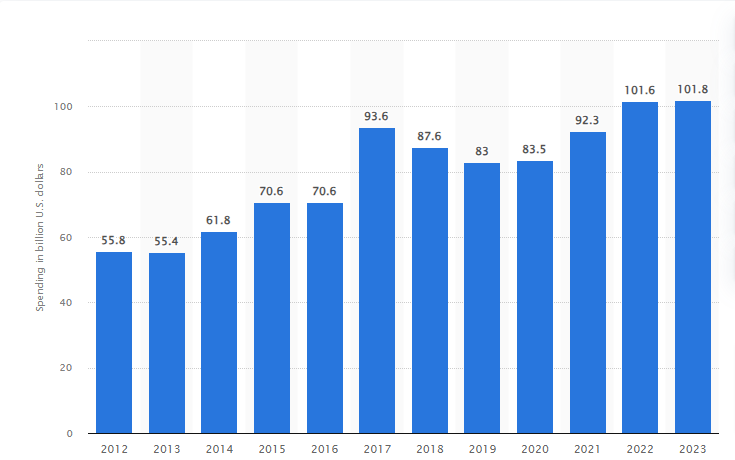As companies adapt to emerging technologies, such as generative AI, in a rapidly changing world, they face significant challenges in the industry of learning and development. The task of keeping employees up-to-date with the latest advancements and empowering them to make a tangible impact on their organizations is more critical than ever.
The digitalization and personalization of learning processes are essential for ensuring long-term success. But how will these transformations unfold in practice? In this article, we will explore the key trends in training for 2024 and how they will redefine the landscape of learning and development. Get ready to discover innovations that will fundamentally transform how employees learn and grow!
As a manager or L&D professional, you might wonder: how can I make training more appealing for employees, and how much impact can this have on the business? According to the latest statistics, upskilling or reskilling processes make a significant difference in a company’s growth. A global survey by Gallup found that companies are 17% more productive and 21% more profitable when they offer training to engaged employees.
It appears that the way training is conducted also matters greatly. A study by HR Dive revealed that 93% of employees want training that is easy to complete and understand, and 89% want these courses to be available anywhere and anytime. This indicates that the training landscape is evolving, and companies must continuously adapt to these changes.
3 important trends for L&D that will shape the future of trainings in 2024
Upskilling, reskilling, and addressing learning gaps represent an ever-growing need for companies worldwide. In the past five years, total spending on employee training has exceeded $100 billion in the USA, according to Statista.
Considering employees’ engagement with courses and the attention they can dedicate to them, three types of learning that are becoming increasingly important in 2024 and beyond are: microlearning, AI-assisted and personalized course creation, and gamification.

Total training expenditures in the United States from 2012 to 2023, as shown by Statista
Microlearning or bite-sized course sessions
In 2024 and beyond, microlearning continues to be a major trend, characterized by short, bite-sized course sessions that allow employees to learn at their own pace, precisely when they need it. This flexible format is ideal for today’s workforce, who prefer concise and readily accessible information. Short, interactive learning modules increase information retention and enable the immediate application of acquired knowledge.
Personalized, AI-Assisted Course Creation
Artificial intelligence (AI) aids in personalizing learning experiences. AI-powered training platforms can quickly create training experiences from scratch or based on existing documents and materials. For L&D professionals, this offers the advantage of speed and efficiency in creating training sessions, which can then be easily customized with their own photos and videos.
Gamification or Learning Through Play
Incorporating game elements into training is becoming increasingly popular, as gamification motivates and engages employees more effectively. By using reward mechanisms, points, medals, badges, and competitions, training sessions become more attractive and stimulating, improving participant engagement and performance. Moreover, this efficient learning method accelerates the application of learned concepts by employees, leading to increased profit margins.
How to Stay Up-to-Date on L&D Trends and Best Practices
As an L&D professional, staying on top of the latest trends and best practices in training is crucial. Given the dynamic nature of the digital landscape in recent years, needs are constantly evolving, and it’s important to stay informed to maintain the highest standards in employee development. Here are some effective strategies:
- Follow Blogs and Industry Websites. Keep up with blogs and websites of industry experts such as ATD (Association for Talent Development), SHRM (Society for Human Resource Management), Training Industry, eLearning Industry, or Codeoftalent.com, which offer updated articles, case studies, and analyses on L&D trends.
- Experiment and Seek Feedback. Experimenting in your own work can help you find new ways to improve your activity and even become a trendsetter. Getting feedback from your learners and managers will help you evaluate the effectiveness of your innovations.
- Get Out of the Office. Spend time with your learners and observe their behavior. Ask questions and find out what their interests are.
- Think Long Term. Try to differentiate trends from fads and think of how a current trend might affect the L&D industry in five years.
Staying updated with the latest trends and best practices in L&D is essential in today’s ever-changing digital landscape. As an L&D professional, continuous adaptation and learning are necessary to uphold high standards in employee development.
Engage with valuable resources from industry experts, follow thought leaders, and participate in events that highlight the latest innovations. Being active in professional communities also offers exclusive insights and networking opportunities, keeping you at the forefront of the industry.
Are you ready to apply the latest training methods for your company’s employees? Our award-winning microlearning platform, Code of Talent, helps you create personalized courses focused on your business needs, offering a modern and successful approach.
Click here to try it now.
In a business world where time is money and every minute counts, measuring the impact of training programs is essential. Without clear and well-defined performance indicators, Learning and Development (L&D) teams risk navigating through uncharted waters, wasting resources like soap bubbles drifting away.
Key Performance Indicators (KPIs) are like a compass in the middle of the ocean, guiding L&D teams towards guaranteed success. These KPIs provide a clear picture of progress and results and answer critical questions when allocating time and money to training: How effective are the courses, and how much have employees learned?
More importantly, how much do the employees’ learned skills reflect in business results? The resources invested in training should contribute to the company’s growth. A global Gallup study shows that companies offering employee training are 21% more profitable and see a 17% increase in productivity.
Why are KPIs Important for the L&D Team?
Key Performance Indicators (KPIs) are measurable metrics that reflect the success of a particular process or activity. In the context of Learning and Development (L&D), KPIs are vital for evaluating the efficiency and impact of training programs.
KPIs are essential for L&D teams for several reasons:
- Alignment with organizational objectives: they ensure that training programs contribute directly to the company’s strategic goals.
- Problem identification and resolution: they allow for the quick detection of areas where training programs are underperforming.
- Resource optimization: they help in efficiently allocating resources by focusing on activities that bring the most significant impact.
- Continuous improvement: they facilitate ongoing adjustments and improvements based on concrete data.
In essence, KPIs act as the navigational aids that steer L&D teams towards achieving their training goals, ensuring that every effort is aligned with broader business objectives and delivers measurable value.
Powerful KPI’s for L&D Teams
1. Completion rate
This can be measured by the percentage of participants who successfully complete a training program. A high completion rate indicates strong interest and commitment from participants. It’s like finishing a marathon without stopping for selfies.
2. Engagement rate
The percentage of participants actively involved in the training programs, whether through active participation in sessions, completion of course materials, or interaction with peers and trainers is an important KPI. High engagement indicates that participants find the content interesting and relevant but also enhances information retention and contributes to a positive learning environment. By monitoring engagement rates, L&D teams can adjust teaching methods and content to keep participants motivated and dedicated throughout the training.
3. Impact on company performance
This KPI measures the direct effect of training programs on overall company performance. It includes metrics such as increased productivity, reduced errors, improved customer satisfaction, and revenue growth.
To truly measure the impact of training programs on overall company performance, start by identifying key metrics such as productivity levels, error rates, customer satisfaction, and revenue growth. Establish a baseline by collecting data on these metrics before implementing the training program. Once the training is completed, gather the same data and compare the results between the trained group and a control group that did not receive the training. For instance, if a sales team that participated in the training shows a significant increase in sales compared to the control group, this demonstrates the positive impact of the training.
4. Participant satisfaction score
Participant satisfaction is a vital KPI that helps in continuously improving the training programs. Develop a detailed satisfaction survey that includes questions on various aspects such as content quality, trainer effectiveness, and overall satisfaction, using a Likert scale to capture nuanced feedback. Collect this feedback immediately after the training session to ensure that participants’ immediate reactions are recorded. Analyze the survey results to calculate average scores and identify trends, which can help pinpoint strengths and areas needing improvement. Comparing these scores with those from previous training sessions can reveal patterns and provide insights for refining future programs, ensuring that the training remains effective and engaging.
5. Knowledge application rate
By measuring participants’ ability to apply acquired knowledge in their daily work, organizations ensure that training translates directly into tangible results. It gauges the real impact of the training on job performance.
To measure the knowledge application rate, start by defining the specific skills or knowledge areas that the training aims to impart. Post-training, assess participants’ ability to apply these skills in their daily tasks through practical evaluations or on-the-job performance reviews. For example, if the training was focused on improving sales techniques, observe how sales representatives implement these techniques in their client interactions and track any changes in sales figures.
Gather feedback from managers and supervisors who oversee the trained employees, as they can provide insights into how well participants are integrating the new skills into their workflows. Additionally, self-assessment surveys can help capture participants’ perspectives on their ability to apply what they have learned.
6. Individual performance improvement
By tracking measurable progress post-training, organizations identify and nurture key talent, unlocking their full potential. It reflects the program’s effectiveness in developing the necessary skills and competencies, like an upgrade to the latest software version, but for people!
7. Time to implement knowledge
This is measured by the interval of time required for participants to apply new knowledge in their daily activities. A short implementation time indicates efficient and easily comprehensible training. Think of it as the time from downloading a program to running it – the quicker, the better!
8. Knowledge retention rate
This KPI measures the percentage of knowledge retained by participants over a period after completing the training. It assesses the durability and relevance of the information provided. It’s like remembering your favorite recipe months after learning it.
9. Training ROI (return on investment)
Calculating the return on investment (ROI) for training programs involves understanding all associated costs, including materials, trainer fees, and participant wages during the training period. Then, measure the financial benefits resulting from the training, such as increased sales, higher productivity, reduced errors, and lower employee turnover rates. Assign monetary values to these benefits to quantify them effectively. This analysis provides a clear picture of the efficiency of training investments, allowing you to demonstrate the financial return to stakeholders.
Conclusion
Key performance indicators are essential for any L&D team aiming to maximize the impact of training programs. Carefully monitoring these KPI’s not only provides valuable insights into the efficiency and relevance of the programs, but also helps align them with the organization’s strategic objectives. Numbers don’t lie, so make sure they’re as accurate and easy to measure as possible.
Lastly, try to save time and resources by creating modern and engaging learning experiences, so that every training session feels like a valuable investment. This not only enhances the learning journey but also ensures that the knowledge sticks and translates into tangible business results. It’s about making every effort count and seeing the impact in real-world outcomes.
Contact Code of Talent’s team today and learn how we can help you achieve your goals.
Photo: Pixabay

